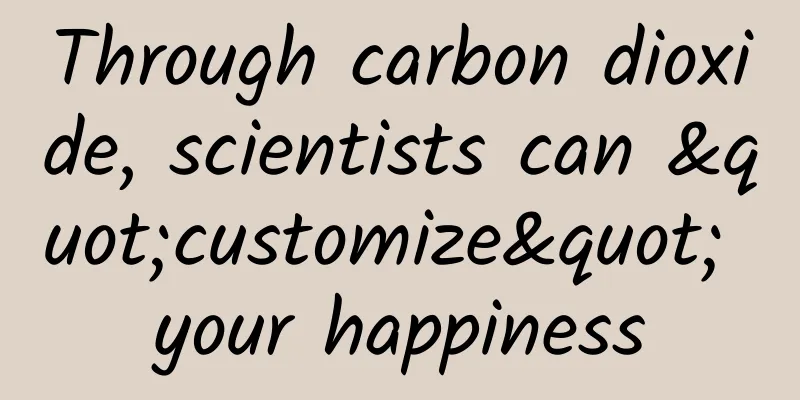Through carbon dioxide, scientists can "customize" your happiness

|
Do you think this article is about "Fat House Happy Water"? Not really. What I want to tell you today is a story about “carbon dioxide turning into sugar”, and it turns into the “healthy sugar” that many people dream of. Eating sugar is fun, but the process of getting sugar may not be Sugar is the most abundant and complex compound in nature, also known as carbohydrates. It is one of the important substances for human food and animal survival. About 70% of the energy needed by the human body is provided by sugar. "Sweets make people happy" is largely because the sugar in them gives us a sweet, pleasant and cheerful feeling. (Photo source: veer photo gallery) However, from ancient times to the present, the process of obtaining sugar is not as pleasant as eating sugar. Green plants on the earth fix carbon dioxide through photosynthesis and store carbohydrates such as starch and sucrose in crops such as corn, wheat, sugar cane, and fruits. People need to use physical, chemical, and biological means and go through a complex sugar production process to obtain sugar. According to historical records, about 4,000 years ago, China mastered the technology of making maltose, which was made from the starch of grains and potatoes, and was called "maltose". For example, there is a line in the Book of Songs: Daya: "Zhouyuan Tengyu, Jintu Ruyi", which shows that maltose existed in the Western Zhou Dynasty. In the Tang Dynasty, the technology of making sugarcane made a breakthrough, and granulated sugar began to appear, and began to spread from royal tribute to the people. Around the 18th century, German scientist Margraf successfully extracted sugarcane from sugar beets, which truly made sugar consumption popular among the people. Today, people have been able to produce a wide variety of sugars with different structures and functions, which are used in various fields of life, including candy, beverages, cooking, medicine, industrial manufacturing, etc. The annual production and consumption of sugar in the world have exceeded 100 million tons, and it has become an indispensable food raw material and energy source in people's lives. However, this traditional "carbon dioxide - biomass resources - sugar" method of making sugar is facing some challenges. Sugar factory and sugarcane (Photo source: Veer Gallery) First, the growing population has an increasing demand for sugar. Limited by the efficiency of plant photosynthesis energy conversion, the method of relying on crops as raw materials to obtain sugar components may not be able to meet the demand in the future. Secondly, with land degradation and shortage, ecosystem degradation, extreme weather and natural disasters caused by global warming, production methods that rely on sugar biomass resources face problems such as raw material supply security and risks; Thirdly, in the long-term natural evolution process, the sugar composition in crops has become relatively fixed, and it is difficult to obtain some rare or naturally non-existent monosaccharide components , which may have important physiological functions. Wait, what is this "rare sugar"? What special function does it have? A rare and healthy sugar Sugars are classified into monosaccharides, disaccharides, and polysaccharides. Monosaccharides are the most basic building blocks of carbohydrates, and are divided into trioses (3 carbon atoms), tetroses (4 carbon atoms), pentoses (5 carbon atoms), hexoses (6 carbon atoms), etc. according to the number of carbon atoms. Hexoses are the most abundant monosaccharides in nature and are most closely related to the body's nutritional metabolism . Glucose molecular formula (Image source: veer gallery) Glucose and fructose are the most abundant hexoses in nature. After being eaten, foods such as steamed bread will eventually enter the human blood in the form of glucose, and be transported to different organs of the human body to produce energy or be converted into proteins, fats, etc. required by the human body. Therefore, glucose is known as an important substance for life structure and energy storage. Fructose is known as the "sweetest" monosaccharide and is widely found in honey. In nature, except for a few sugars such as glucose and fructose, most hexoses are rare in nature. In 2002, this type of sugar was defined as rare sugar by the International Rare Sugar Society. The so-called rare sugar mainly refers to a type of monosaccharide that is rare in nature. Demonstration chart of the natural content of rare sugars (Source: International Rare Sugars Society ISRS) Among them, allulose is an important rare sugar, which tastes similar to sucrose (70% of the sweetness of sucrose), has low calories (0.4Kcal/g), and has a glycemic index (GI) of almost zero . Studies have shown that allulose has the effect of inhibiting blood sugar rise and preventing obesity, and may become a sugar substitute for people with diabetes and obesity. (Source: Nature Communication, 2018, 9, 113) As a sweetener, rare sugars can not only satisfy people's desire for sweetness, but also show physiological effects that are beneficial to the body. With the implementation of sugar reduction and sugar tax policies in various countries, the demand for rare sugars is expected to continue to increase. But the problem arises again. In nature, the raw materials for "healthy sugar" are scarce, and traditional manufacturing methods alone will certainly not be able to meet the demand. At this time, do you think of "carbon dioxide turns into starch"? Starch is made of glucose polymerization. Since carbon dioxide can turn into starch, can it turn into 6-carbon sugars of other structures? "Customized" synthesis of sugars: a leap from "years" to "hours" Recently, the Tianjin Institute of Industrial Biotechnology of the Chinese Academy of Sciences (referred to as "Tianjin Institute of Industrial Biotechnology") has developed a technology for artificially converting carbon dioxide to accurately synthesize sugars from scratch, realizing the "customized" synthesis of a variety of hexoses from carbon dioxide, and constructing an artificial biological system with flexibility, efficiency and versatility, providing the possibility of breaking away from the natural synthesis pathway and using carbon dioxide to create a diverse "sugar world". The technical route of artificially converting carbon dioxide into hexose (Image source: Tianjin Institute of Industrial Biotechnology, Chinese Academy of Sciences) In 2021, the Tianjin Industrial Biology Laboratory achieved the artificial synthesis of starch from carbon dioxide, proving the feasibility of artificial synthesis pathways that do not rely on nature, and laying a technical foundation for the institute's research on carbon dioxide-based sugar synthesis (click here to review). Standing on the shoulders of the achievements in starch, the Tianjin Institute of Industrial Biology cooperated with the research team of the Dalian Institute of Chemical Physics, Chinese Academy of Sciences, to design and construct chemical-enzyme coupled non-natural transformation pathways based on enzymatic reactions such as carbon condensation, isomerization, and dephosphorylation, and engineered the catalytic properties of enzyme protein molecules to achieve precise control of the synthesis of hexoses with different structures and functions, including rare sugars such as allulose . The reaction time of the whole experiment is about 17 hours. Compared with the traditional method of extracting sugar by planting crops such as sugarcane, the time of obtaining sugar has achieved a leap from "years" to "hours". The efficiency of sugar synthesis this time is 0.67 grams per liter per hour, which is more than 10 times higher than the known research. The carbon fixation synthesis efficiency of glucose reaches 59.8 nanomoles of carbon per milligram of catalyst per minute, which is the highest level of artificial sugar production known at home and abroad . At the same time, a biological system that can further extend the types and configurations of sugar products has been established, which can realize the artificial creation of sugar molecule diversity. This research achievement is a major breakthrough based on the synthesis of starch from carbon dioxide. It subverts the paradigm of relying on the conversion of sugar biomass resources to prepare complex sugar molecules , and provides a flexible and scalable sugar manufacturing model that can obtain functional sugar molecules that are scarce in nature, thereby expanding the scope of application. The obtained sugar can be used as a raw material in food, medicine and other fields, and can also be used as a key raw material for industrial biomanufacturing to synthesize other chemicals, further meeting other material needs of mankind. This research also provides a new solution for the conversion and utilization of carbon dioxide: converting carbon dioxide into starch, sugar and other necessities for production and life will reduce carbon dioxide emissions. Artificial conversion of carbon dioxide to synthesize hexose solution sample (Image source: Tianjin Institute of Industrial Biotechnology, Chinese Academy of Sciences) Manfred T. Reetz, an internationally renowned organic chemist, expert in biocatalysis, and member of the German Academy of Sciences, commented that converting carbon dioxide into carbohydrates is a particularly interesting idea and also very challenging. The results have made a real breakthrough in this competitive research field, providing a flexible, versatile and efficient sugar synthesis route. Now, we have achieved a breakthrough in the technical route of artificial precision synthesis of hexose, but there is still a long way to go before industrial production. I believe that with the advancement of science and technology, related scientific and engineering technology problems can be solved. We can not only "customize" sugar that brings happiness to people, but also "customize" a low-carbon future. Author: Yang Jiangang and Sun Yuanxia Author unit: Tianjin Institute of Industrial Biotechnology, Chinese Academy of Sciences This article is from the "Science Academy" public account. Please indicate the source of the public account when reprinting. |
Recommend
Link Motion issued a shareholder letter on related issues
Beijing time, September 18, 2018 – Link Mobility ...
If Apple makes good use of Touch ID, it will have a bright future
If Apple can successfully deploy Touch ID mobile p...
[Li Jiaoshou] I have 3 ways to extend the life cycle of Internet celebrities
Indeed, many internet celebrities nowadays (such ...
Question: What color are blueberries? Few people know the truth!
Color is a language of plants. Through colors, we...
What is the difference between underwear that costs 20 yuan and underwear that costs 200 yuan?
Underwear plays an important role in shaping wome...
Is your iPhone frozen and shut down during the cold snap? Should Apple be blamed for this?
Do you know the loneliness you feel when your cel...
Comparison of the world's top 5 mobile phone fast charging speeds: iPhone ranks last
Nowadays, the performance of mobile phones has soa...
Some basic techniques for operation, promotion and attracting new customers!
Operations is a very complex business system. Gen...
I never use 5G, but why don’t I buy a non-5G phone?
5G has not yet gained widespread consumer awarene...
Startup App, 4 Cold Start Methods from 0 to 1
When cold-starting , Internet products can be rou...
Don't wear silver jewelry randomly, the water inside is a bit deep
In our daily life, we can see a lot of silver orn...
Who is the strongest king? Entry-level 120GB SSD competition
We once predicted that SSD would replace HDD and ...
How to build a good live broadcast room?
I believe everyone is already familiar with the c...
WeChat iOS 8.0.9 official version released: known issues resolved
[[411759]] WeChat iOS 8.0.8 official version was ...
The journey of snail noodles is not only stinky and fragrant, but also has these 3 highlights
Guangxi is a place with little presence. It does ...









